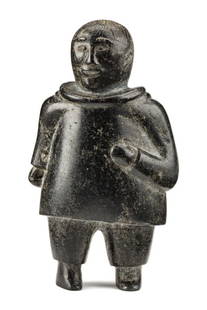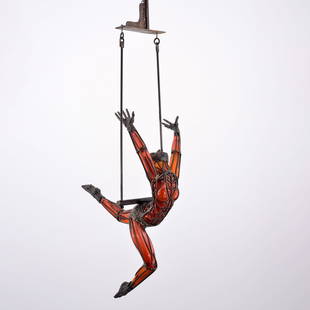
UNIDENTIFIED ARTIST, NUU-CHAH-NULTH / COAST SALISH,
Similar Sale History
View More Items in Sculptures & Carvings

Related Sculptures & Carvings
More Items in Native American Sculptures & Carvings
View MoreRecommended Art
View More









Item Details
Description
UNIDENTIFIED ARTIST, NUU-CHAH-NULTH OR COAST SALISH
Large Model Canoe with Figures,late 19th century
wood, pigment, and metal, 4 x 57.25 x 4.25 in (10.2 x 145.4 x 10.8 cm)
unsigned.
Provenance
A Canadian Collection.
Model canoes had limited presence in Northwest Coast cultures, but can be found in the oldest European collections and have even been recovered archaeologically, dating back 300 years. These may have been made for children, but other cultural purposes are also possible. Model canoes, like model totem poles, became widely popular in the mid to late nineteenth century, and canoe models representing all the historical types survive from that time, and continue to be made by contemporary artists today.
Canoe races have probably taken place on the coast throughout history, but organized competitive races became widespread around 1900. On the southern coast, primarily among the Coast Salish, canoe racing reached throughout their region of influence, from southern British Columbia to western Washington State. Nearly every Native community in the area supports a fleet of racing canoes, pulled by crews both male and female. The smallest racing canoes are singles, about twelve feet long. Races are held throughout the summer in a wide range of traditional locations.
In the nineteenth century, the Nuu-chah-nulth canoe style, with a greater reputation for seaworthiness established on the ocean, came to replace the indigenous Salish canoe in the Puget Sound / Salish Sea region, the dominating presence in historical photos of the area. Similarly, when purpose-built racing canoes were developed, fifty-five feet long, little more than two feet wide, and crewed by eleven ‘pullers’, they were most often embellished with bow and stern elements from the Nuu-chah-nulth style canoe. This model, designed for only six pullers, in full size would be about forty feet long, and very fast.
Steven C. Brown
Literature: For three early-mid 19th century canoe models (Nuu-chah-nulth or Makah) see Steven C. Brown, Native Visions: Evolution in Northwest Coast Art from the Eighteenth through the Twentieth Century (Seattle: Seattle Art Museum / Vancouver: Douglas & McIntyre, 1998), pp. 64-65; and a Makah example c. 1890 (ibid.), p. 137.
Large Model Canoe with Figures,late 19th century
wood, pigment, and metal, 4 x 57.25 x 4.25 in (10.2 x 145.4 x 10.8 cm)
unsigned.
Provenance
A Canadian Collection.
Model canoes had limited presence in Northwest Coast cultures, but can be found in the oldest European collections and have even been recovered archaeologically, dating back 300 years. These may have been made for children, but other cultural purposes are also possible. Model canoes, like model totem poles, became widely popular in the mid to late nineteenth century, and canoe models representing all the historical types survive from that time, and continue to be made by contemporary artists today.
Canoe races have probably taken place on the coast throughout history, but organized competitive races became widespread around 1900. On the southern coast, primarily among the Coast Salish, canoe racing reached throughout their region of influence, from southern British Columbia to western Washington State. Nearly every Native community in the area supports a fleet of racing canoes, pulled by crews both male and female. The smallest racing canoes are singles, about twelve feet long. Races are held throughout the summer in a wide range of traditional locations.
In the nineteenth century, the Nuu-chah-nulth canoe style, with a greater reputation for seaworthiness established on the ocean, came to replace the indigenous Salish canoe in the Puget Sound / Salish Sea region, the dominating presence in historical photos of the area. Similarly, when purpose-built racing canoes were developed, fifty-five feet long, little more than two feet wide, and crewed by eleven ‘pullers’, they were most often embellished with bow and stern elements from the Nuu-chah-nulth style canoe. This model, designed for only six pullers, in full size would be about forty feet long, and very fast.
Steven C. Brown
Literature: For three early-mid 19th century canoe models (Nuu-chah-nulth or Makah) see Steven C. Brown, Native Visions: Evolution in Northwest Coast Art from the Eighteenth through the Twentieth Century (Seattle: Seattle Art Museum / Vancouver: Douglas & McIntyre, 1998), pp. 64-65; and a Makah example c. 1890 (ibid.), p. 137.
Buyer's Premium
- 20%
UNIDENTIFIED ARTIST, NUU-CHAH-NULTH / COAST SALISH,
Estimate CA$4,000 - CA$6,000
5 bidders are watching this item.
Shipping & Pickup Options
Item located in Toronto, Toronto, caSee Policy for Shipping
Local Pickup Available
Payment

TOP

















































![Shoushan stone white hibiscus stone carving [Happy] seal ornaments: Shoushan stone white hibiscus stone carving [Happy] seal ornaments, stone, delicate and translucent, with clear lines, a good collection for viewing! Specifications: 6.5×2.5×2.5cm Weight: 157g](https://p1.liveauctioneers.com/8621/323106/174834532_1_x.jpg?height=310&quality=70&version=1712860375)
![Ming Dynasty, finely cast bronze gilt statue of Avalokitesvara: Ming Dynasty, finely cast bronze gilt statue of Avalokitesvara[Specifications] Height 38.8cm Width 25cm Weight 7.3kg[Details]This statue of Avalokitesvara wears a hood and a Buddha in front of his bun](https://p1.liveauctioneers.com/8621/323106/175518185_1_x.jpg?height=310&quality=70&version=1712860375)

![Ming Dynasty, finely cast bronze gilded statue of Manjusri Bodhisattva: Ming Dynasty, finely cast bronze gilded statue of Manjusri Bodhisattva[Specifications] Height 30cm, width 18.8cm, weight 3.85kg[Details]Manjusri Bodhisattva is one of the four great Bodhisattvas in Bu](https://p1.liveauctioneers.com/8621/323106/175230357_1_x.jpg?height=310&quality=70&version=1712860375)

![Ming Dynasty, finely cast bronze gilded statue of Marpa sitting: Ming Dynasty, finely cast bronze gilded statue of Marpa sitting[Specifications] Height 24.5cm Width 17.6cm Weight 3.55kg](https://p1.liveauctioneers.com/8621/323106/175190735_1_x.jpg?height=310&quality=70&version=1712860375)
























